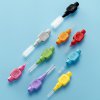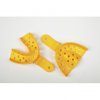The Helix test checks the ability of the autoclave to sterilise hollow objects such as suction or irrigation tubes.
The tests should be carried out daily on a specific cycle, vacuum autoclave, so that the different sterilisation cycles of the day can then be carried out.
Tests are available in packs containing 100 or 250 strips + test capsule tube.
Packages:
1 x 100 pcs.
1 x 250 pcs.
| Category: | Tests |
|---|
Properties:
- The test consists of a 1.5 metre long tube open at one end. The other end is closed by a hermetically sealed capsule which contains a strip printed with an indicator ink.
- It is an essential test because dental practices have instruments with rather long cavities which, if not sterilised properly, can transmit bacteria and viruses to the patient and operator.
- The Helix test simulates the operation of the autoclave with regard to the sterilisation of porous loads and, in particular, is used to evaluate: the effectiveness of the pre-vacuum and thus the penetration of steam into the cavities; and the values of temperature and saturated steam pressure during the sterilisation phase.
- This test can only be used in Class B autoclaves.
Method of use:
- Subject this test to a sterilisation cycle of 134°C for 3 to 5 minutes to simulate the sterilisation performance of an autoclave for a "complex" medical device.
- The steam should penetrate the inside of the coiled tube, which is deliberately narrow, and cause a reaction on the strip printed with the indicator ink.
- If the ink on the strip turns completely black then the sterilisation is successful.
- However, if the ink is still yellow or partially yellow then the test is considered negative (this means that the vapour has not penetrated properly to the indicator).
- It is then advisable to call in a professional repairer who will be able to validate the origin of the anomaly (incorrect calibration, contact time too low, etc.).
Traceability:
To ensure traceability, it is important to keep each test result in a register.
The objective being to always prove the good functioning of the equipment in case of infection of a patient.














